Detecting, disassembling, studying, soldering and jamming police radars and lidars
A long time ago, in 1902, three policemen were sitting in the bushes (at 1 mile intervals), each with a stopwatch and a telephone. It sweeps past the first car, it immediately tracks the time and calls the second, the second makes mathematical calculations and calls the third, and that one already stops the car. ( proof )
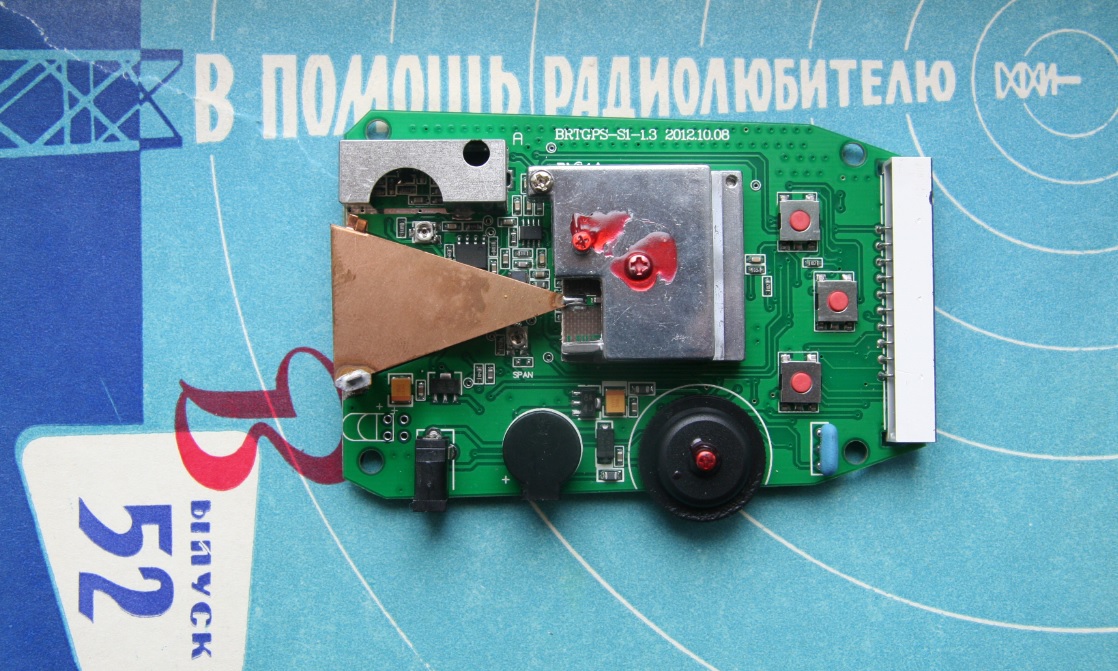
"Radar detector" in the analysis. (A radar detector is a passive receiver of police radar signals that warns the driver about the need to comply with the set speed limit.)
Today we will talk about electronic warfare devices on our roads.
While radar detectors and radar detectors are not prohibited here, we do not have electronic warfare, but in some countries the war is underway. We can only prepare.
Radars, radar detectors, radar detector detectors. About what happen, how to make / saw it yourself and both.
(Thanks to the online store fonarimarket.ru for the equipment provided)
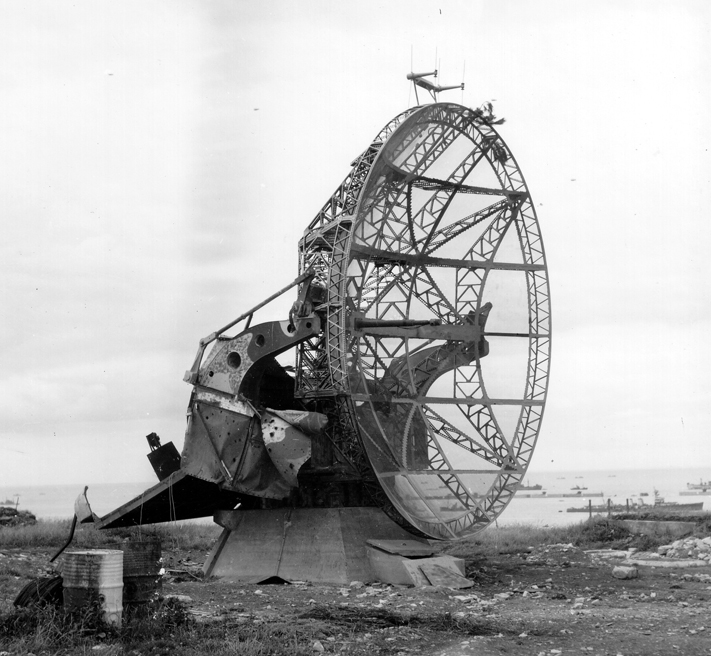
The world's first radar
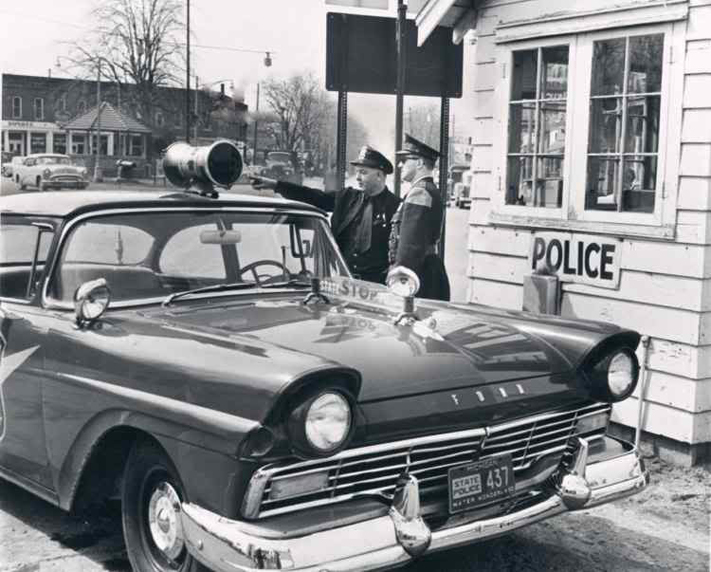
The world's first car radar
One of the first police radars of the mid-20th century:
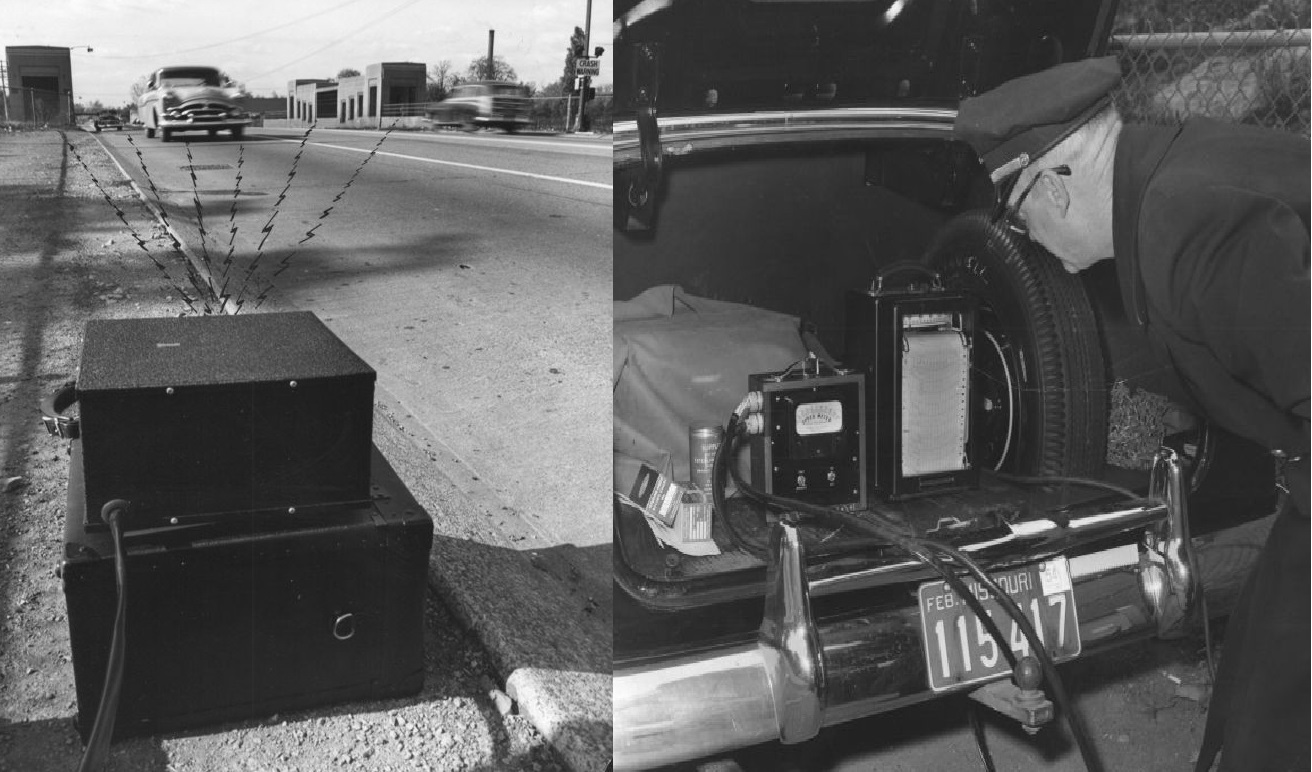

blogs.sydneylivingmuseums.com.au/justice/index.php/2011/04/05/a-deterrent-for-scorchers
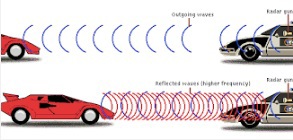 Radio frequency radar ( Doppler radar) emits a high-frequency radio signal of X-, K- or Ka-band in the direction of the car. The frequency of the reflected signal changes in proportion to the speed of the object. Having received the reflected signal, the radar measures the frequency deviation and calculates the speed of the car. The obtained speed value is displayed on the radar display or transmitted to the situational center if the radar is stationary.
Radio frequency radar ( Doppler radar) emits a high-frequency radio signal of X-, K- or Ka-band in the direction of the car. The frequency of the reflected signal changes in proportion to the speed of the object. Having received the reflected signal, the radar measures the frequency deviation and calculates the speed of the car. The obtained speed value is displayed on the radar display or transmitted to the situational center if the radar is stationary.
Traffic police radar ranges are determined by international agreements. Three ranges are certified in Russia, the frequencies of all the radars used by the traffic police in our country should be within their limits.
X-band (operating frequency 10.525 GHz). The first detectors worked in this range, but today they have almost completely given way to equipment using other frequencies, although some foreign and Russian (BARRIER, FALCON) continue to use it.
K-band (carrier frequency 24.150 GHz). Basic for the vast majority of DPS radars in the world. Devices working in it are more compact, but have a greater detection range than X-range devices.
L-band (1-2GHz). VG-2
Range(16000 MHz) - the range that the police of some European countries (where radar detectors are prohibited) use to detect cars with radar detectors.
The promising ranges K a and K u in Russia are not yet certified, and radar cameras of these ranges are not used here. The detectors used by motorists are tuned to the traffic police radar ranges of all frequencies used in our country.
 The second type of police radar - laser radar(lidar) or, as it is still rarely called, optical. Lidar emits short laser pulses outside the visual range (IR), with a fixed time interval, in the direction of the car. These pulses are reflected from the vehicle and received by a laser meter. Lidar captures the change in the distance to the object by the delay time of each reflected pulse. The digital lidar device calculates the speed of the car using data on the change in range for a fixed period of time.
The second type of police radar - laser radar(lidar) or, as it is still rarely called, optical. Lidar emits short laser pulses outside the visual range (IR), with a fixed time interval, in the direction of the car. These pulses are reflected from the vehicle and received by a laser meter. Lidar captures the change in the distance to the object by the delay time of each reflected pulse. The digital lidar device calculates the speed of the car using data on the change in range for a fixed period of time.
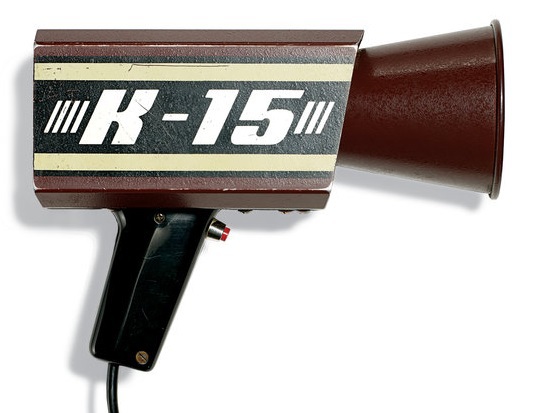
Legality The
use of radar detectors is officially authorized in Russia, Ukraine, Belarus, Moldova, Kazakhstan and all other countries of the Commonwealth, in the USA (except for the state of Virginia and in Washington, DC), Great Britain, Iceland, Bulgaria, Romania, Slovenia, Albania, Israel , Japan, India, Pakistan, Taiwan, New Zealand.
Radar detectors are prohibited for use in Canada (except the states of British Columbia, Alberta and Saskatchewan), Brazil, Finland, Norway, Sweden, Belgium, Ireland, Switzerland, Denmark, Germany, Austria, Holland, Luxembourg, France, Spain, Portugal, Italy , Greece, Croatia, Serbia, Slovakia, Poland, Hungary, Bosnia, the Czech Republic, Estonia, Latvia, Lithuania, Turkey, Jordan, Singapore, Malaysia, Egypt, Saudi Arabia, the United Arab Emirates, South Africa, Australia (excluding the state of Western Australia).
History

The world's first radar detector for motorists
Promoted such gadgets through the magazine "Popular Electronics" (1961):
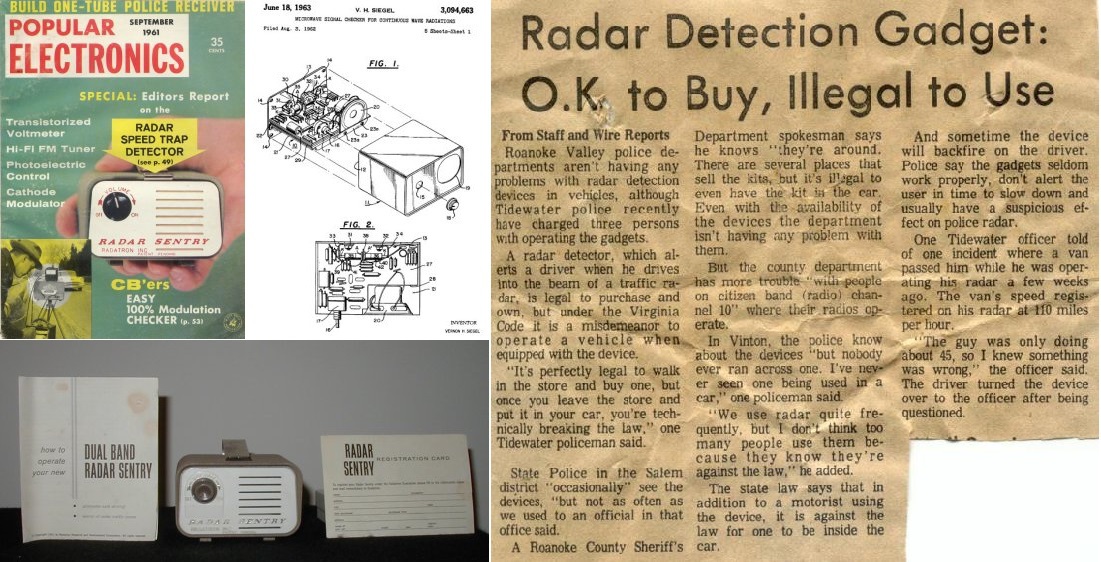
Source
Later models:
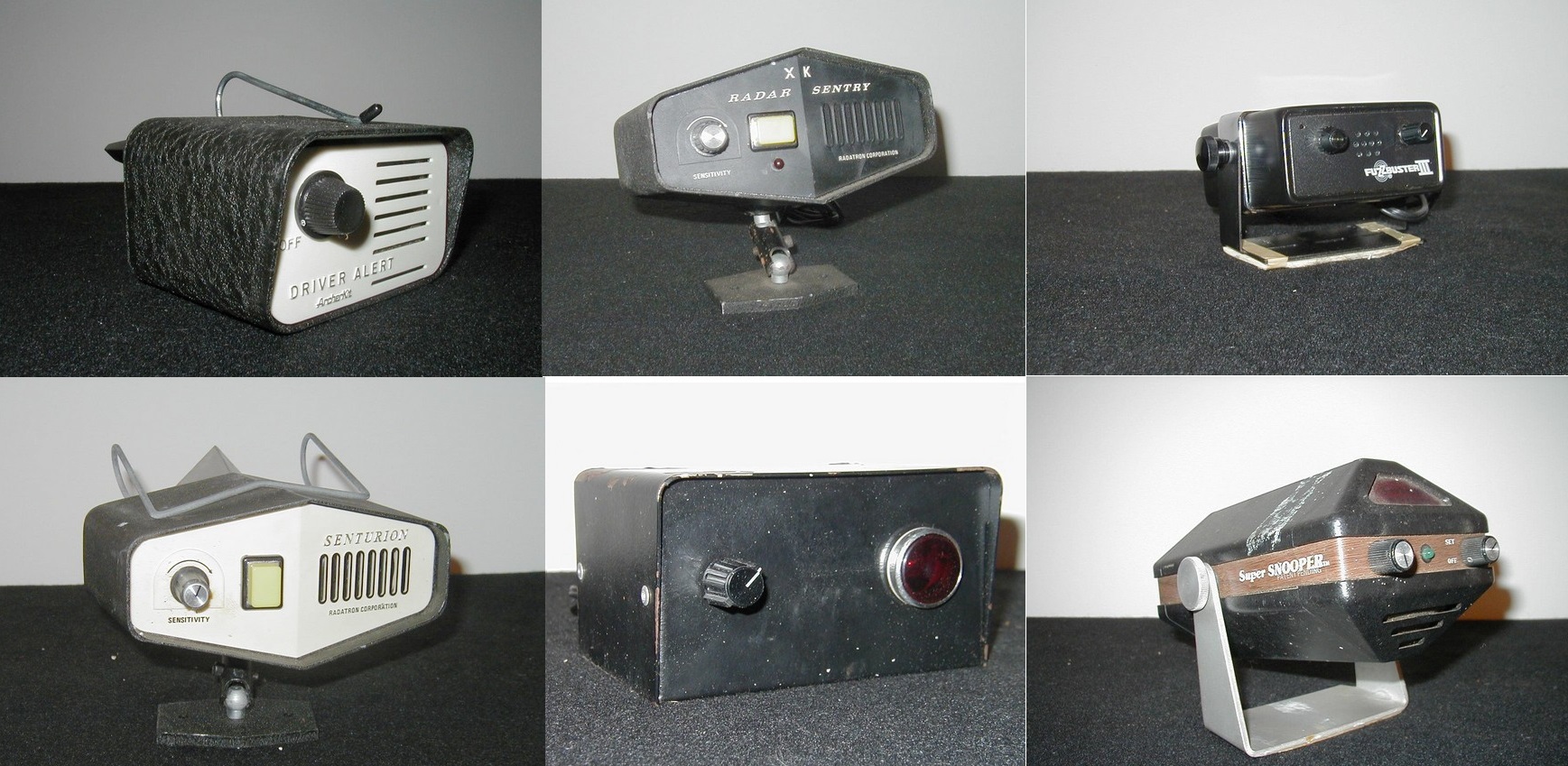
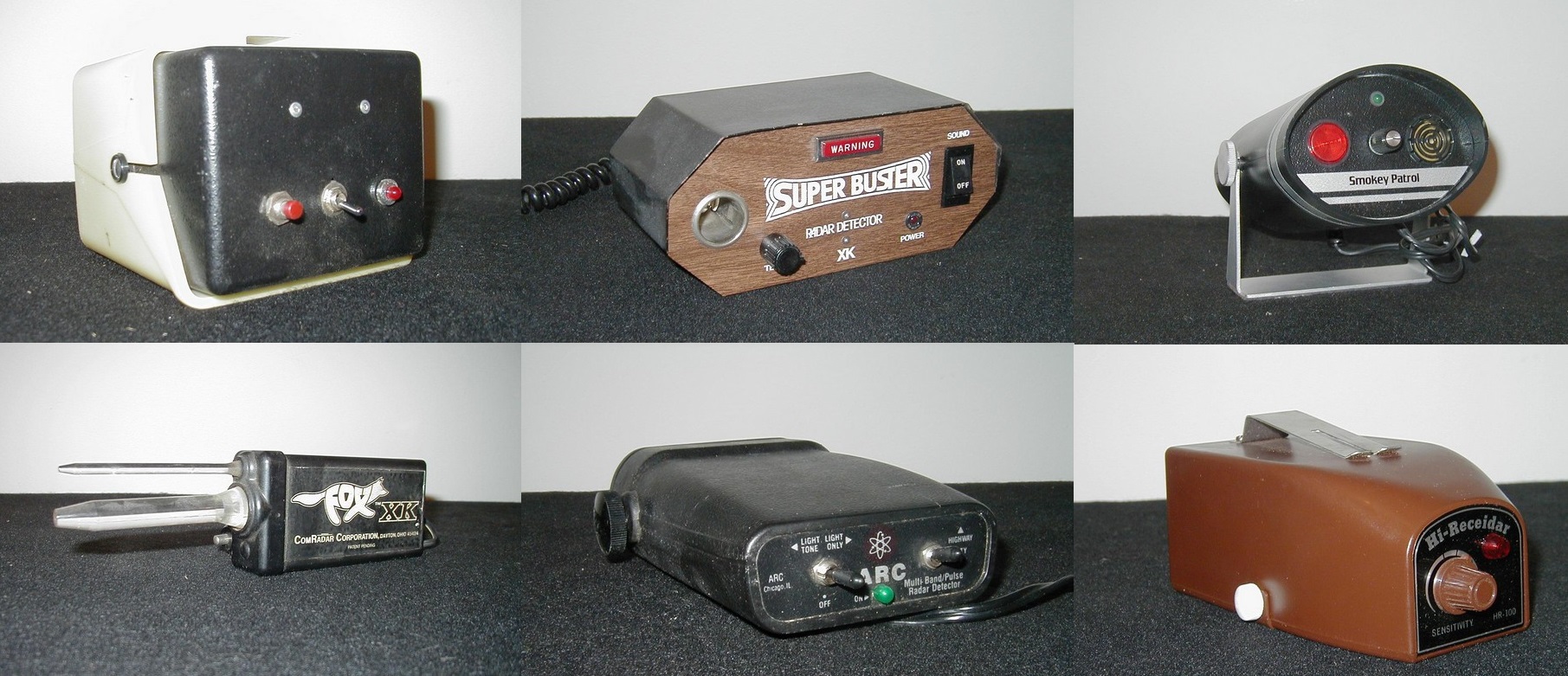
Museum of radar detectors - www.radardetectormuseum.com The
interiors of modernradar detector SHO-ME 520 STR
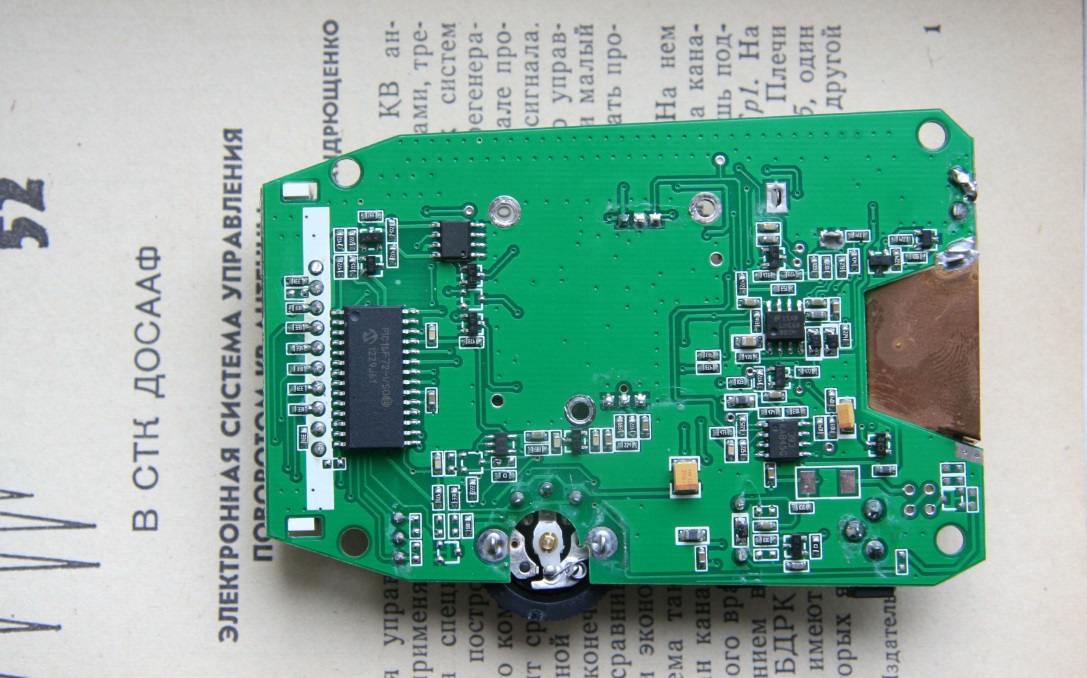
Bottom view
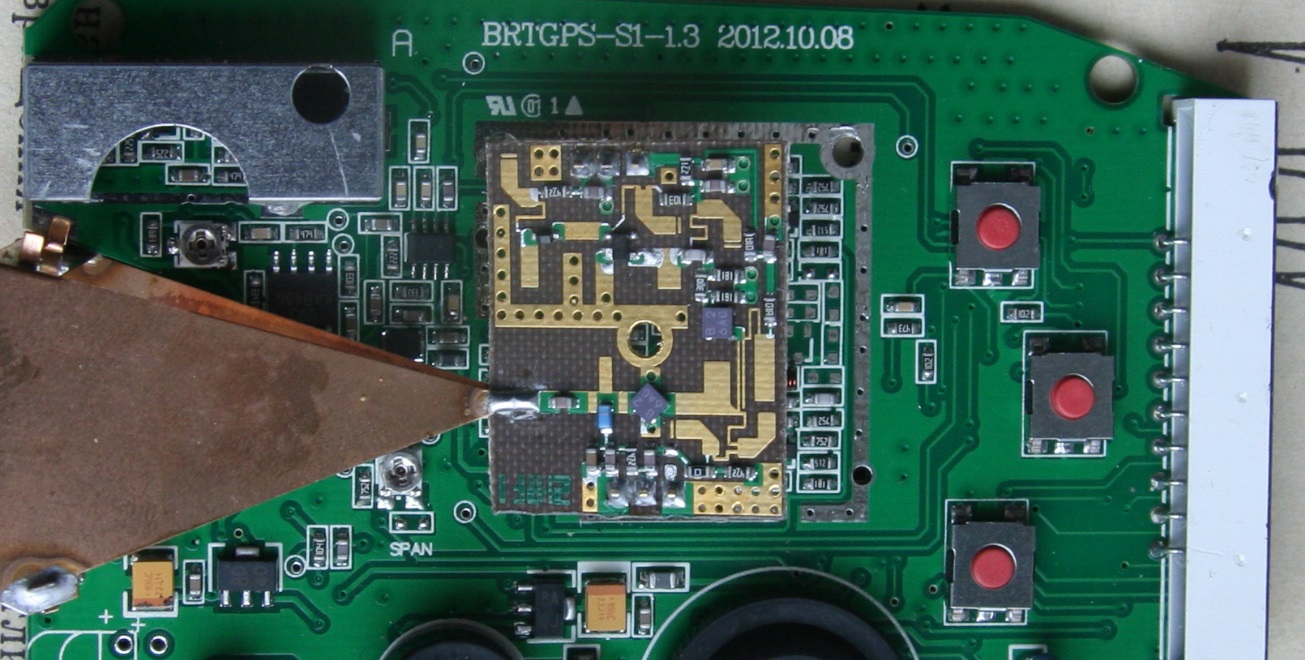
With the radiator removed (corrected in the comments - this is an RF screen. It just shields the local oscillator radiation and also protects the receiving path from external interference. Thanks r00tGER ). At the top left is a laser detector, below is a copper horn antenna. In the center is the HF module. To the right - 3 control buttons. Right (white) - Display
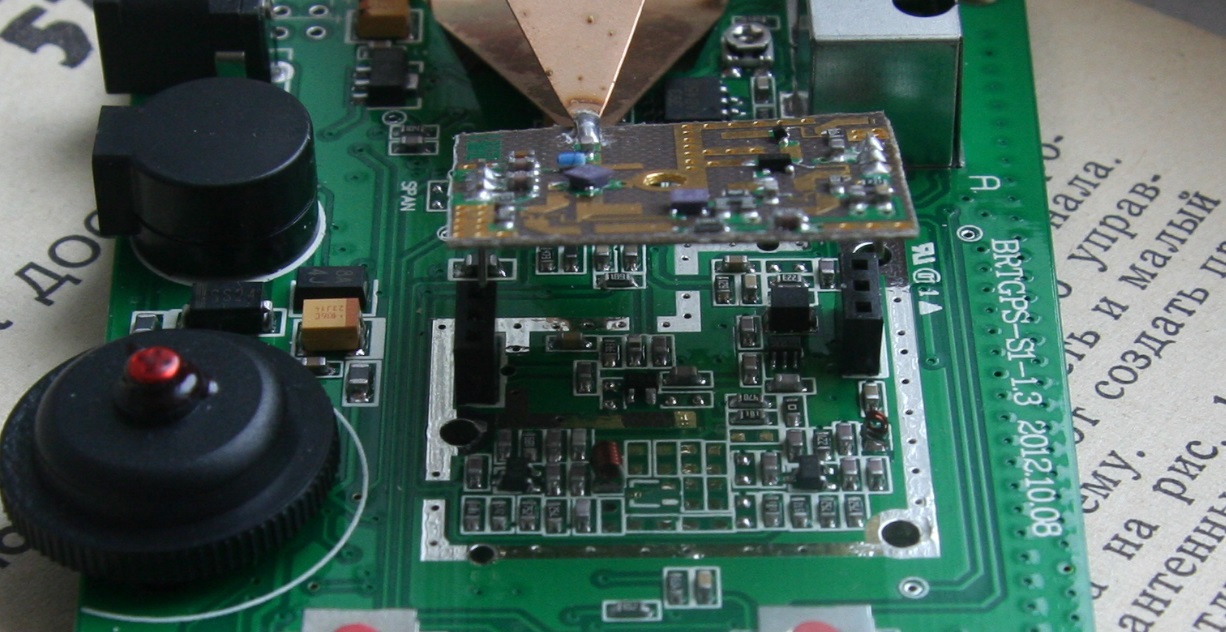
Under the RF screen
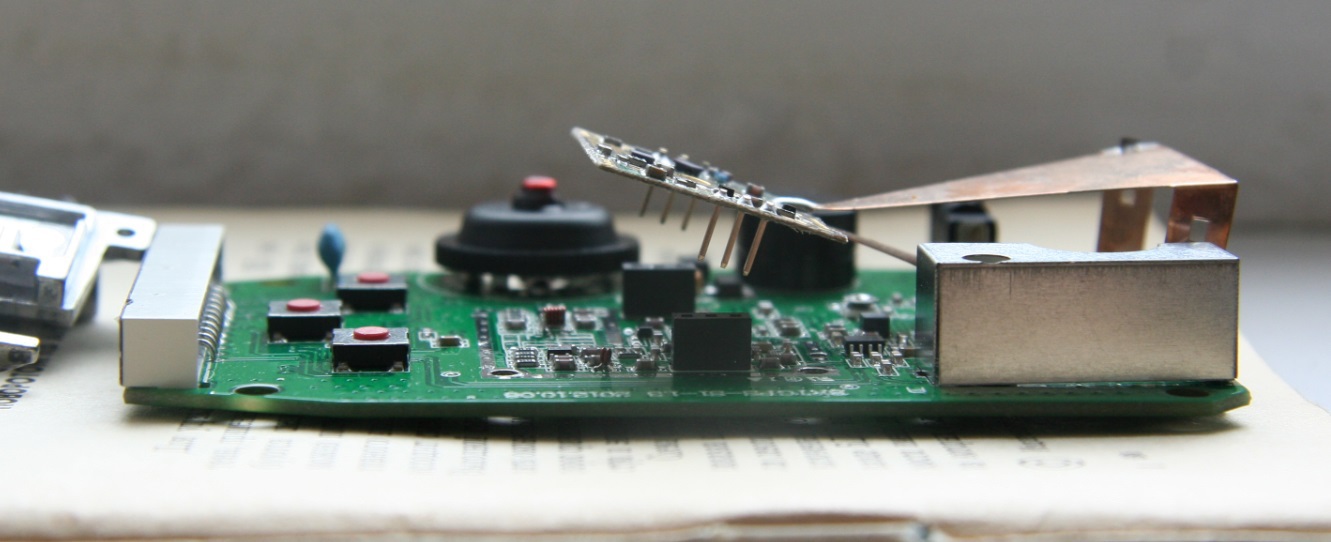
False signals are radio signals from other devices operating in the ranges of police radars, but which have nothing to do with the latter. For example, automatic store doors can operate in the X- and K-bands, satellite equipment signals can be detected by the X-band radar detector, radio signals of all ranges, as well as laser signals, can be detected in territories adjacent to airports.
Radar detectors use software and hardware methods of protection against false radio signals. Hardware methods involve the installation of specialized filters in the receiver of a radar detector, and software methods include special algorithms that can identify a radar signal and cut off its signal from interference. But sometimes these methods are not enough, especially when using a radar detector in an urban environment with a lot of interference from foreign devices. To do this, all modern radar detectors have a manual change in the sensitivity of the device - switching between the "City" and "Track" modes. Depending on the "jamming" situation, the driver can independently adjust the sensitivity of his device and minimize the number of false positives of the radar detector.
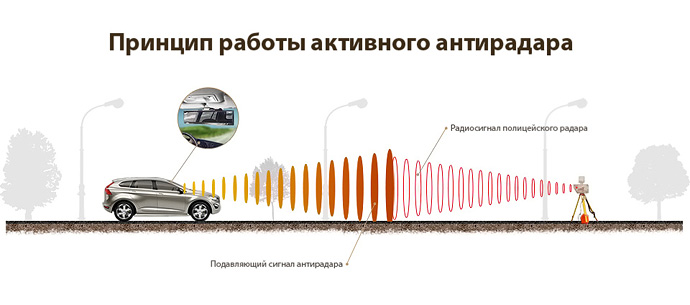
Antiradar is an active type device. It is equipped not only with a radio receiver for signal detection, but also with a radio transmitter that emits signal interference. It is this signal that disrupts the work of police radars: it mixes the signal coming from the radar with radio noise (“white noise”). The radar radio receiver receives a distorted signal and cannot determine the speed of the machine, to which the radio signal was sent.
These devices are prohibited almost everywhere. This device is included in the list of devices included in the Law “On counteraction to traffic authorities”.
Laser Radar Detector
During their work, in response to the signal sent by the police radar, laser radar detectors send their shifted in phase. As a result, the policeman receives an underestimated speed value. It is worth noting that the price range for devices of this type is significant. This is explained both by the manufacturer’s brand and its “hype” in the market, as well as by the manufacturing method and the used components. The most expensive are laser radar detectors of a hidden or spaced installation, as well as those capable of simultaneously processing a large number of (up to eight) signals simultaneously, determining the power and level of the signal.
It is also not recommended to use “jammers” against lidars, as they are already included in the list of the Law “On counteraction to traffic authorities”.
Laser Jammer Demo:
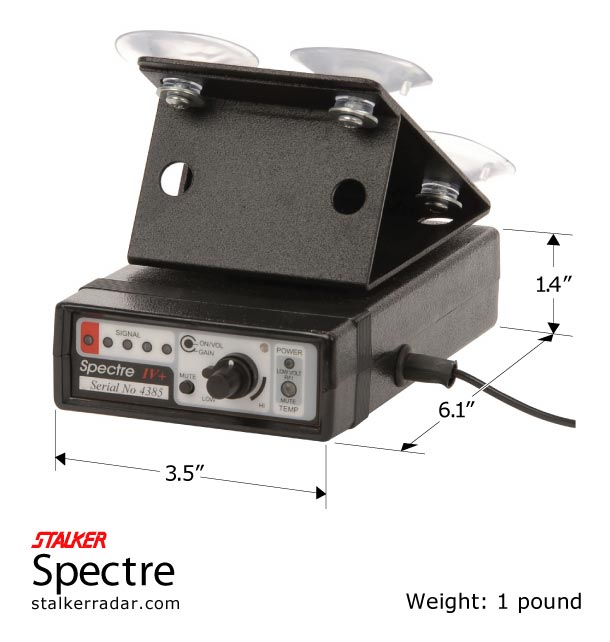
High Sensitive Direction Finder
In a number of foreign countries, radar detectors are prohibited by law. In order to determine whether a radar detector is in the car or not, the VG-2 system (16000 MHz) was invented. The principle of operation - the machine is irradiated with a signal of a certain frequency, because there are many radio parts inside the radar detector, they cause “interference” to this signal and, by their presence or absence, the device gives out whether the radar detector is in the car or not.
Modern radar detector have the function of detecting VG-2 devices (in fact, when a VG-2 is detected, the radar simply turns off for a while).
All radar detectors can be divided into 2 main groups - heterodyne and direct amplification. Direct gain detectors cannot initially be detected by such devices. they have structurally no radiation. In heterodyne detectors, in the process of signal processing, a local oscillator is used, which is a radiation source (minimal, but there is). It is this radiation that can be captured by supersensitive devices to search for a radar detector at a distance. The distance can reach several hundred meters.
With the VG-2 option in the detector, the radar detector, in addition to the usual radar frequencies, also scans this allocated frequency for the detection of a signal from such a device. When a signal is detected, all local oscillators in the detector are turned off, and with them the reception of radar signals and thus the detector is protected from detection. The detector is fully switched on only after the signal disappears in the VG-2 range.
In addition to VG-2, which is already an outdated technology, there are Spectrum-type devices that also remotely detect the presence of a heterodyne radar detector in a car. Unlike VG-2, the Spectrum does not have a dedicated frequency and therefore it cannot be detected in advance. The only protection against detection by Spectra is to reduce the radiation level of the local oscillator due to shielding and the use of low-noise signal amplifiers.
Counteraction to the detector of radar detectors
1. Do not use a local oscillator in the design of the radar detector - there are no radiating elements, there is no problem, but the direct amplification radar detector is not very sensitive;
2.VG-2 systems can be counteracted by turning off the local oscillator and this is done in most radar detectors. As soon as the radar detector detects a signal in the VG-2 range, it turns off the local oscillator and thus prevents detection. When using this method, there is one very important side effect - at the time the VG-2 signal is detected, the radar detector cannot detect radar signals since its local oscillator is disconnected. This method works only with VG-2, and the Spectrum systems have a different principle and this method is not possible.
3.To counter the Spectra, manufacturers of the radar detector by all available means reduce the radiation emitted by the local oscillator to the outside. For this, shielding, metal cases, resonance tuning are used - these are among the passive methods. Active ones include the use of low noise amplifiers (LNAs), lower local oscillator frequencies, etc. methods. Using several methods at the same time can protect the radar detector from detection, but there are not many completely undetectable radar detectors, but their number is constantly increasing as manufacturers switch to higher technologies. The first completely undetectable radar detector was the Beltronics STi. When using this method of counteraction, there are no side effects.
In Russia, the functions of VG and Specter are not relevant, since we do not have a ban on the use of radar detectors, although the media now and then there are notes on attempts by the authorities of certain regions to introduce such restrictions, such as in Tatarstan.
A large box catches a small box:
What is happening in the do-it-yourself environment and at hacker conferences.
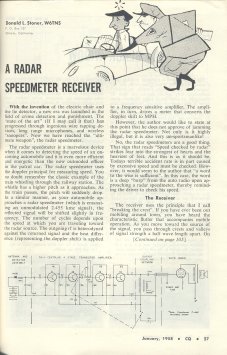
Scheme for self-assembly of a radar detector for radio amateurs (1958)
The hacker’s job of making coffee can’s radar is based on the scientific publication of a doctor from MIT, which describes the possibility of creating 2D and 3D images using aperture radar synthesis

In Massachusetts, they even took a course on this subject
DEFCON 19: Build your own Synthetic Aperture Radar:
For 900 bucks you can buy a kit for assembly :

Anboxing training kit with cans:
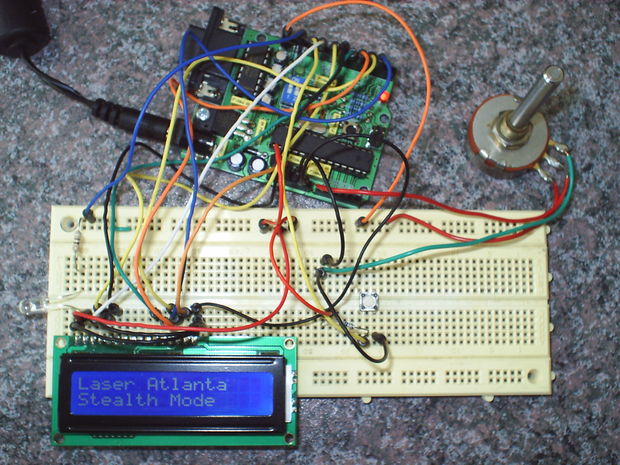
Test your radar detector or laser jammer with this traffic enforcement LIDAR gun simulator
If you want to build your own laser jammer or your own laser radar detector, you will need this device that simulates the operation of police laser detection systems.
The device mimics one of 11 systems:
each of which runs on 904nM, some systems emit 100 pulses per second, some 238.
We test our gadget for vulnerabilities.

From a toy:
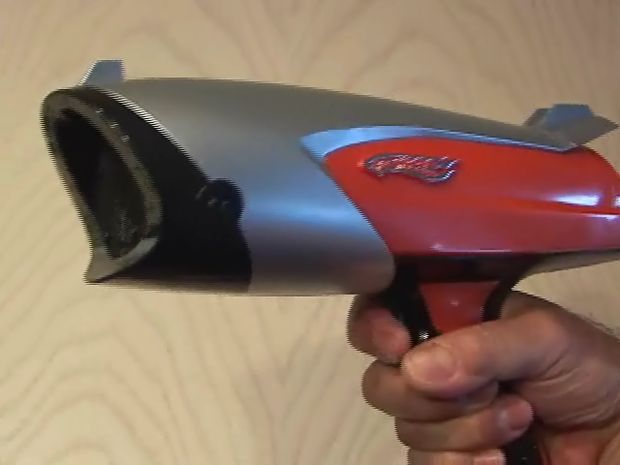
For $ 25
With a saw, washers and a bottle:

Make a device for those who want to become a policeman:

Another comrade was not satisfied with the power of the previous “toy” (10 meters), and he washed down his horn antenna and amp: the
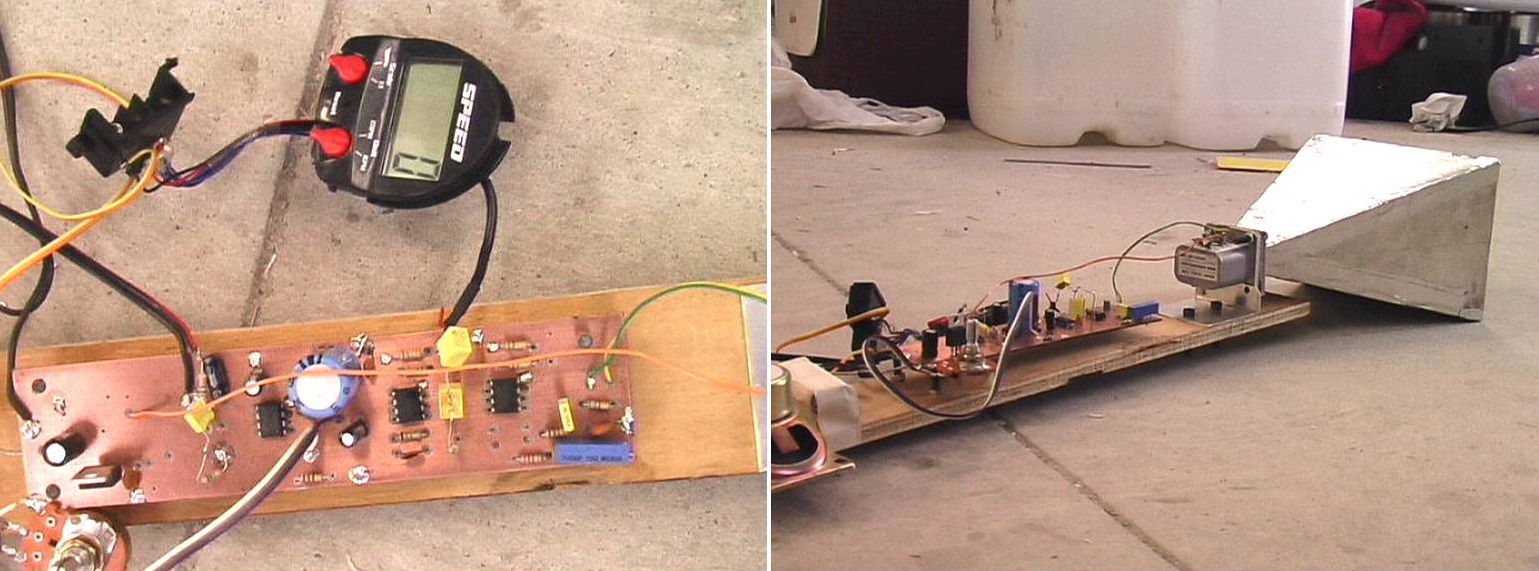
craftsman wants to measure the speed of airplanes. He figured out the relics, but the next step is to upgrade the chip, because it has a speed limit of 100 mph, and he needs more. ( Source )
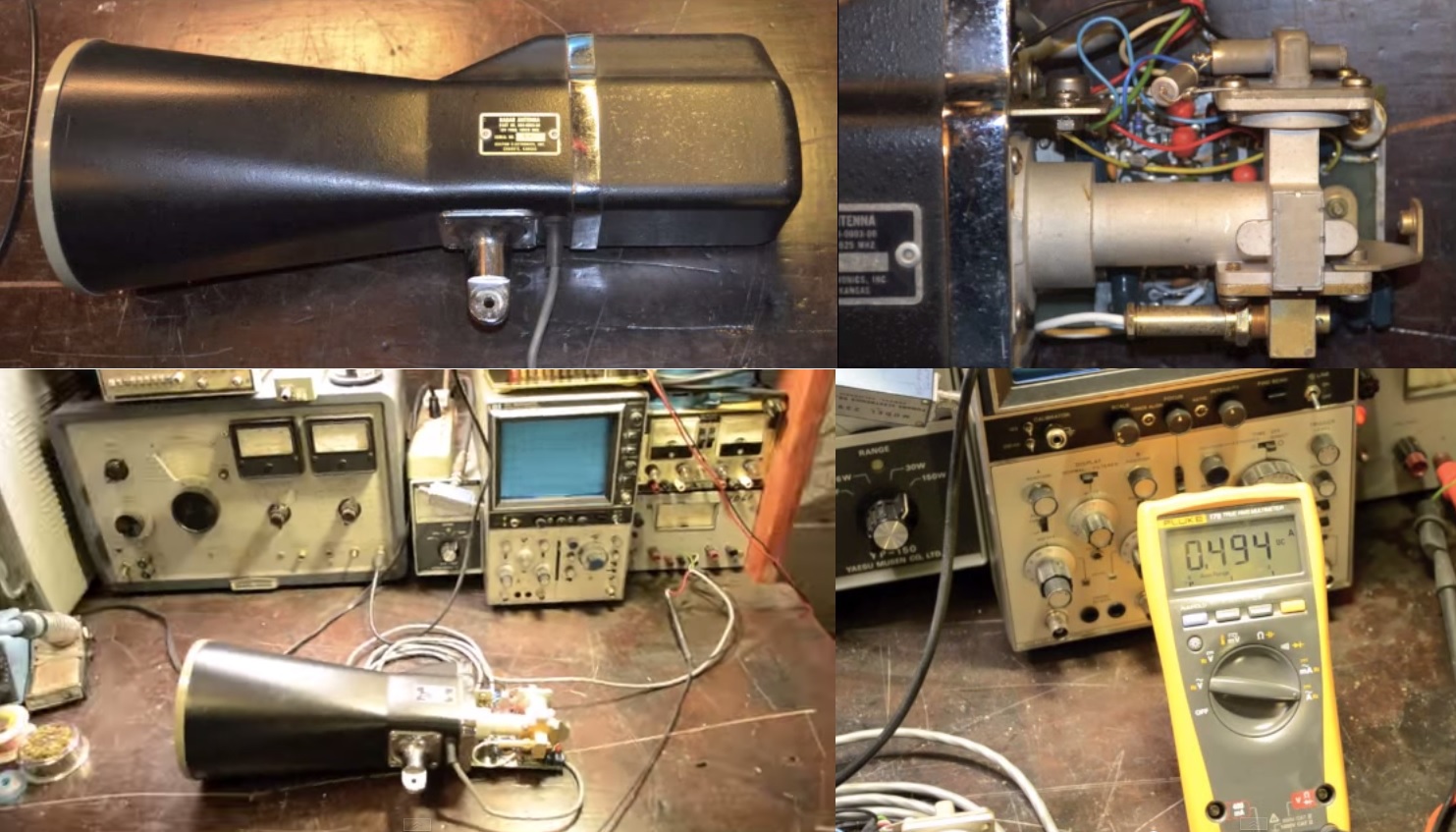
Having found grandfather's radar in the attic, the craftsman fiddled with the oscilloscope and soldered the adapter from the radar to the laptop through the audio input. And then he successfully processed the signal on the computer.
source
P.S.

"Radar detector" in the analysis. (A radar detector is a passive receiver of police radar signals that warns the driver about the need to comply with the set speed limit.)
Today we will talk about electronic warfare devices on our roads.
While radar detectors and radar detectors are not prohibited here, we do not have electronic warfare, but in some countries the war is underway. We can only prepare.
Electronic warfare (EW) is a type of warfare, during which the effect of radio emissions (radio interference) on the electronic equipment of enemy control systems, communications and reconnaissance in order to change the quality of military information circulating in them, protect their systems from similar influences, as well as change conditions (environmental properties) propagation of radio waves. WikipediaHow to resist the one who is trying to remove information about you without your knowledge and how to protect your "personal data" from unauthorized removal.
Radars, radar detectors, radar detector detectors. About what happen, how to make / saw it yourself and both.
(Thanks to the online store fonarimarket.ru for the equipment provided)
Radar

The world's first radar

The world's first car radar
One of the first police radars of the mid-20th century:


blogs.sydneylivingmuseums.com.au/justice/index.php/2011/04/05/a-deterrent-for-scorchers
 Radio frequency radar ( Doppler radar) emits a high-frequency radio signal of X-, K- or Ka-band in the direction of the car. The frequency of the reflected signal changes in proportion to the speed of the object. Having received the reflected signal, the radar measures the frequency deviation and calculates the speed of the car. The obtained speed value is displayed on the radar display or transmitted to the situational center if the radar is stationary.
Radio frequency radar ( Doppler radar) emits a high-frequency radio signal of X-, K- or Ka-band in the direction of the car. The frequency of the reflected signal changes in proportion to the speed of the object. Having received the reflected signal, the radar measures the frequency deviation and calculates the speed of the car. The obtained speed value is displayed on the radar display or transmitted to the situational center if the radar is stationary.Traffic police radar ranges are determined by international agreements. Three ranges are certified in Russia, the frequencies of all the radars used by the traffic police in our country should be within their limits.
X-band (operating frequency 10.525 GHz). The first detectors worked in this range, but today they have almost completely given way to equipment using other frequencies, although some foreign and Russian (BARRIER, FALCON) continue to use it.
K-band (carrier frequency 24.150 GHz). Basic for the vast majority of DPS radars in the world. Devices working in it are more compact, but have a greater detection range than X-range devices.
L-band (1-2GHz). VG-2
Range(16000 MHz) - the range that the police of some European countries (where radar detectors are prohibited) use to detect cars with radar detectors.
The promising ranges K a and K u in Russia are not yet certified, and radar cameras of these ranges are not used here. The detectors used by motorists are tuned to the traffic police radar ranges of all frequencies used in our country.
 The second type of police radar - laser radar(lidar) or, as it is still rarely called, optical. Lidar emits short laser pulses outside the visual range (IR), with a fixed time interval, in the direction of the car. These pulses are reflected from the vehicle and received by a laser meter. Lidar captures the change in the distance to the object by the delay time of each reflected pulse. The digital lidar device calculates the speed of the car using data on the change in range for a fixed period of time.
The second type of police radar - laser radar(lidar) or, as it is still rarely called, optical. Lidar emits short laser pulses outside the visual range (IR), with a fixed time interval, in the direction of the car. These pulses are reflected from the vehicle and received by a laser meter. Lidar captures the change in the distance to the object by the delay time of each reflected pulse. The digital lidar device calculates the speed of the car using data on the change in range for a fixed period of time.
Guns big brother
Spark-1 Radar Spark-1
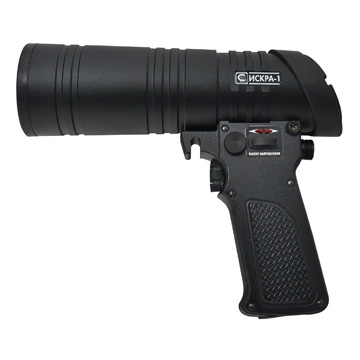 Radar is a reliable and efficient speed meter operating in the K-band. For 15 years, the radar has been successfully used by road guard services to control the speed limit on Russian roads. Iskra-1 operates at a double frequency of the K-band, which significantly increases the reliability of measurements in adverse weather conditions. A distinctive feature of the Iskra-1 models is the monopulse method of measuring speed. This mode provides high performance of the device: the radar calculates the vehicle’s motion parameters in just 0.2 seconds. Moreover, the radar is practically invisible to all radar detectors of foreign manufacture that are not adapted to the Russian conditions: they all perceive the Iskra short-pulse signal as an obstacle.
Radar is a reliable and efficient speed meter operating in the K-band. For 15 years, the radar has been successfully used by road guard services to control the speed limit on Russian roads. Iskra-1 operates at a double frequency of the K-band, which significantly increases the reliability of measurements in adverse weather conditions. A distinctive feature of the Iskra-1 models is the monopulse method of measuring speed. This mode provides high performance of the device: the radar calculates the vehicle’s motion parameters in just 0.2 seconds. Moreover, the radar is practically invisible to all radar detectors of foreign manufacture that are not adapted to the Russian conditions: they all perceive the Iskra short-pulse signal as an obstacle.
Characteristics
Type Radar
Operating frequency of the speed meter 24050-242550 MHz (K-band)
Controlled directions of movement all directions
Speed measurement mode stationary, patrol (on the move)
Detection range up to 800 m
Speed measurement range 30–220 km / h
Measurement error ± 1 km / h
Model number
"Spark-1B" is intended to work in a steady state, preferably in one direction. The radar allows you to select a vehicle in the traffic stream with the highest speed in almost any conditions, exceeding the flow rate by only 5 km / h.
Iskra-1D is the first Russian radar capable of operating in all directions in a moving patrol car. In one second, the radar manages to make a five-fold measurement of the target’s own speed and speed, eliminate possible errors, process the measurement results and display them on a display that consistently displays the target’s speed, own speed and time from the start of the measurement.
Radar Sokol-M
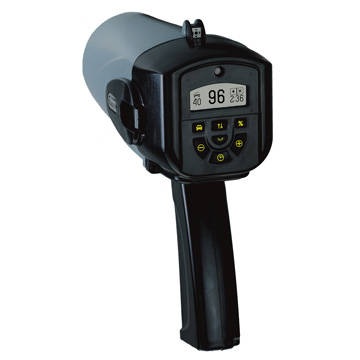 The Sokol-M mobile radar is an autonomous radar speed meter operating in the obsolete X-band. The device is designed to determine the speed of oncoming cars only. Dimensional, easy to use, the radar is able to control the speed of both individual cars and those moving in the stream at a distance of 300-500 m. It is perfectly recognized by "white" radar detectors of any price category. The Sokol-M radar was discontinued in 2008, but due to its high reliability, ease of use and relatively low price, it is now widely used in Russia and the Commonwealth countries.
The Sokol-M mobile radar is an autonomous radar speed meter operating in the obsolete X-band. The device is designed to determine the speed of oncoming cars only. Dimensional, easy to use, the radar is able to control the speed of both individual cars and those moving in the stream at a distance of 300-500 m. It is perfectly recognized by "white" radar detectors of any price category. The Sokol-M radar was discontinued in 2008, but due to its high reliability, ease of use and relatively low price, it is now widely used in Russia and the Commonwealth countries.
Characteristics
Instrument type radar
Operating frequency of the speed meter 10500-10550 MHz (X-band)
Controlled directions of movement all directions
Speed measurement mode stationary patrol (in motion)
detection range up to 600 m
of speed measurement range of 20-250 km / h
measurement error ± 2 km / h
Lineup
"Falcon-M-C" is intended to control the stationary-speed mode and has an adjustable range of actions. All Sokol-M models operate in Ultra-X pulsed mode, which makes these radars elusive for radars of the lowest price category and models that are not adapted for use in Russian conditions.
Sokol-MD is intended for measuring the speed of oncoming and passing vehicles in a moving patrol car.
"Sokol-Visa" - a mobile complex for measuring speed and video recording is a Sokol-M radar, which is paired with a digital video camera. The system operates in a stationary mode (installed primarily on a stationary patrol car) and can only measure the speed of oncoming cars. The Sokol-Visa complex captures on the video not only violations of the high-speed mode, but also traffic to a red light and the intersection of solid lanes - it is almost impossible to challenge such a charge of violating traffic rules.
Radar "Binar"
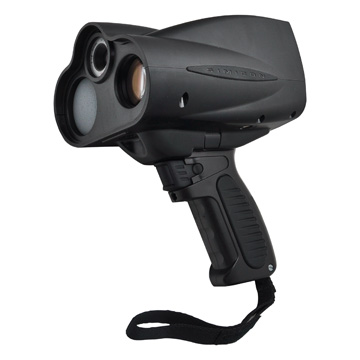 A feature of Binar is the presence of two cameras: the first serves for a wide overview of the traffic situation, the second takes close-up shots of the intruder’s car with a distinguishable license plate at a distance of up to 200 m. The device is able to work stationary or while the patrol car traffic police. The presence of two videos in addition to the readings of the radar simplify the control of the situation on the road and increase the reliability of identifying a traffic violator. "Binar" is equipped with a non-volatile memory card in SD format, has a low weight, is able to charge from the vehicle's on-board network and can synchronize with a computer. Radar control is carried out using the remote control or touch screen.
A feature of Binar is the presence of two cameras: the first serves for a wide overview of the traffic situation, the second takes close-up shots of the intruder’s car with a distinguishable license plate at a distance of up to 200 m. The device is able to work stationary or while the patrol car traffic police. The presence of two videos in addition to the readings of the radar simplify the control of the situation on the road and increase the reliability of identifying a traffic violator. "Binar" is equipped with a non-volatile memory card in SD format, has a low weight, is able to charge from the vehicle's on-board network and can synchronize with a computer. Radar control is carried out using the remote control or touch screen.
Characteristics
Instrument type radar, video fixer
Operating frequency of the speed meter 24050-242550 MHz (K-band)
Controlled directions of movement all directions
Speed measurement mode stationary, patrol
Detection range up to 300 m
Speed measurement range 20-300 km / h
Measurement error ± 2 km / h
Radar Radis
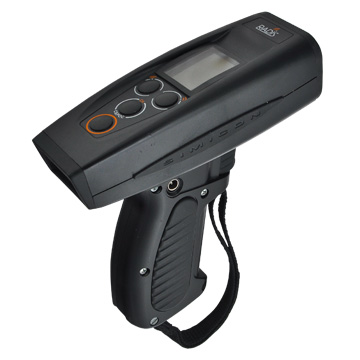 Radar "Radis" has high accuracy and fast measurement speed with the ability to select the nearest or fastest car from the traffic stream. The device is capable of measuring speed in both the opposite and the associated directions, it is equipped with two displays with bright backlight and has simple controls using the on-screen menu. The radar is capable of taking speed measurements while charging from the vehicle’s on-board network. The weight of the device is only 450 g. Radis can be installed in the cabin, as well as on the hood or roof of a patrol car using a magnetic stand. Using the remote control, the radar can be controlled remotely.
Radar "Radis" has high accuracy and fast measurement speed with the ability to select the nearest or fastest car from the traffic stream. The device is capable of measuring speed in both the opposite and the associated directions, it is equipped with two displays with bright backlight and has simple controls using the on-screen menu. The radar is capable of taking speed measurements while charging from the vehicle’s on-board network. The weight of the device is only 450 g. Radis can be installed in the cabin, as well as on the hood or roof of a patrol car using a magnetic stand. Using the remote control, the radar can be controlled remotely.
Characteristics
Instrument type radar
Operating frequency of the speed meter 24050-242550 MHz (K-band)
Controlled directions of movement all directions
Speed measurement mode stationary, patrol
Detection range up to 800 m
Speed measurement range 10-300 km / h
Measurement error ± 1 km / h
Radar "Golden eagle"
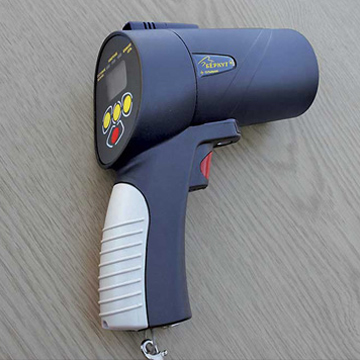 The Berkut police radar is designed to control the speed of single vehicles or cars in heavy traffic. It has the ability to select the nearest or fastest car. The radar is equipped with a backlight indicator and buttons, allowing the traffic police inspector to record the speed of the car in the dark. The Golden Eagle can work for 10 hours without recharging and measure the speed both stationary and in patrol mode. The radar is easy to use and easy to mount on the dashboard of a car. Depending on the situation, you can attach a handle, bracket or video clip to the device.
The Berkut police radar is designed to control the speed of single vehicles or cars in heavy traffic. It has the ability to select the nearest or fastest car. The radar is equipped with a backlight indicator and buttons, allowing the traffic police inspector to record the speed of the car in the dark. The Golden Eagle can work for 10 hours without recharging and measure the speed both stationary and in patrol mode. The radar is easy to use and easy to mount on the dashboard of a car. Depending on the situation, you can attach a handle, bracket or video clip to the device.
Characteristics
Instrument type radar
Operating frequency of the speed meter 24050-242550 MHz (K-band)
Controlled directions of movement all directions
Speed measurement mode stationary
Detection range up to 800 m
Speed measurement range 20-250 km / h
Measurement error ± 2 km / h
Radar “Vizir”
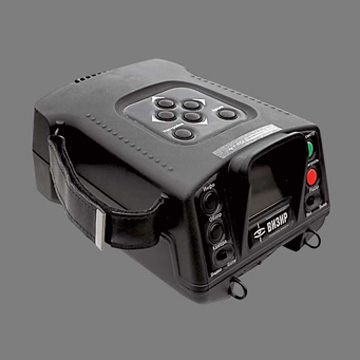 While determining the speed, the Vizir radar takes photos and videos of the intruder’s car, which helps the traffic police inspector to resolve disputes. The results of speed measurements, as well as the control date and time, are entered into the picture taken by the Vizier. The device takes measurements in all directions and is able to work both stationary and in a patrol car. The radar is equipped with a built-in LCD display and a simple menu with a convenient arrangement of control keys. The device has a function of automatic speed measurement and recording traffic violations. "Vizir" can be connected to an external monitor and transfer data to a computer.
While determining the speed, the Vizir radar takes photos and videos of the intruder’s car, which helps the traffic police inspector to resolve disputes. The results of speed measurements, as well as the control date and time, are entered into the picture taken by the Vizier. The device takes measurements in all directions and is able to work both stationary and in a patrol car. The radar is equipped with a built-in LCD display and a simple menu with a convenient arrangement of control keys. The device has a function of automatic speed measurement and recording traffic violations. "Vizir" can be connected to an external monitor and transfer data to a computer.
Characteristics
Instrument type radar, video
fixator Operating frequency of the speed meter 24050-242550 MHz (K-band)
Controlled directions of movement all directions
Speed measurement mode stationary, patrol
Detection range up to 600 m
Speed measurement range 20–250 km / h
Measurement error ± 2 km / h
Strelka radar complex The Strelka
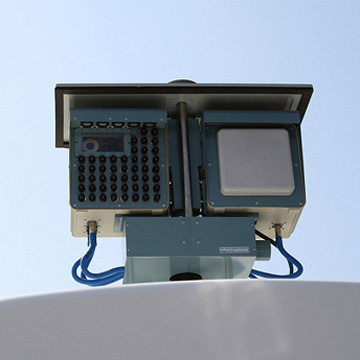 radar complex accurately measures the speed of all vehicles, caught in its coverage area (500 m from the installation site), regardless of the density of the traffic flow. The Strelka camera records the excess of the set speed limit at a distance of 350 to 50 m to the installation site and photographs the intruder’s car with clearly distinguishable license plates. The received data is processed by a computer and transmitted to the information processing center via a fiber optic line or via a radio channel.
radar complex accurately measures the speed of all vehicles, caught in its coverage area (500 m from the installation site), regardless of the density of the traffic flow. The Strelka camera records the excess of the set speed limit at a distance of 350 to 50 m to the installation site and photographs the intruder’s car with clearly distinguishable license plates. The received data is processed by a computer and transmitted to the information processing center via a fiber optic line or via a radio channel.
Characteristics
Instrument type radar, photofixer
Operating frequency of the speed meter 24050–24250 MHz (K-band)
Controlled directions of movement all directions (up to 4 lanes)
Speed measurement mode stationary, patrol
Detection range up to 500 m
Minimum detection range 50 m
Speed measurement range 20-300 km / h
Measurement accuracy ± 1 km / h Strelka-01-ST
model range
is a stationary device installed above the carriageway and transmitting information to the control center via fiber optic communication.
"Strelka-01-STR" is a stationary device installed above the carriageway and transmitting information to the radio control center.
"Arrow-01-STM" - a mobile version of the device with the possibility of placement on a patrol car.
Radar complex "Arena" The
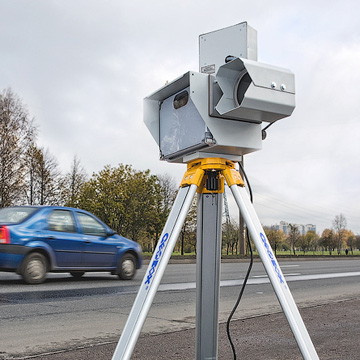 hardware-software complex "Arena" is designed to automatically control the speed limit on a specific section of the road. Preparation of the complex for work takes about 10 minutes. “Arena” is mounted on a tripod 3-5 m from the edge of the roadway. Cars that exceed the high-speed threshold are automatically photographed, and information about violations is transmitted to the traffic police post or stored in the device's memory. The radar complex is powered by a battery located nearby in a special box.
hardware-software complex "Arena" is designed to automatically control the speed limit on a specific section of the road. Preparation of the complex for work takes about 10 minutes. “Arena” is mounted on a tripod 3-5 m from the edge of the roadway. Cars that exceed the high-speed threshold are automatically photographed, and information about violations is transmitted to the traffic police post or stored in the device's memory. The radar complex is powered by a battery located nearby in a special box.
Characteristics
Instrument type radar, photofixer, agribusiness
Operating frequency of a speed meter 24050-242550 MHz (K-band)
Controlled directions of movement oncoming
Speed measurement mode stationary
Detection range up to 90 m
Speed measurement range 20–250 km / h
Measurement error ± 2 km / h
Chris photoradar complex The Chris
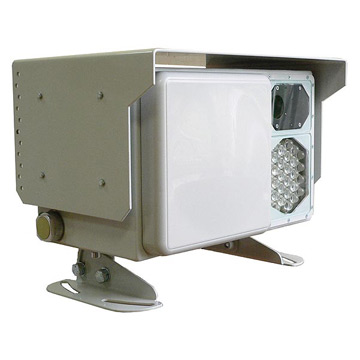 photoradar complex is designed to automatically record traffic violations, recognize vehicle numbers, and check them by federal or regional databases and data transfer to a remote traffic police post. The device is equipped with an infrared camera, which allows it to work at night. "Chris" is installed on a tripod near the edge of the roadway and will measure the speed of only those cars that are in the frame.
photoradar complex is designed to automatically record traffic violations, recognize vehicle numbers, and check them by federal or regional databases and data transfer to a remote traffic police post. The device is equipped with an infrared camera, which allows it to work at night. "Chris" is installed on a tripod near the edge of the roadway and will measure the speed of only those cars that are in the frame.
Characteristics
Instrument type radar, photofixer
Operating frequency of the speed meter 24050–24250 MHz (K-band)
Controlled directions of movement all directions
Speed measurement mode stationary
Detection range up to 150 m
Speed measurement range 20-250 km / h
Measurement error ± 1 km / h Chris-S
model range
is a standard model of a photo radar complex.
Chris-P is an improved model with a new photoradar sensor.
Radar "Rapira-1"
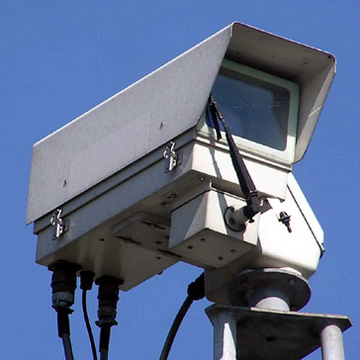 Radar "Rapira-1" is used only for stationary measurement of speed of vehicles, it is able to work separately or as part of various hardware and software systems. The radar is installed at a distance of 4-9 meters above the road at an angle of 25 ° and allows you to determine the speed of the car in a narrow control zone.
Radar "Rapira-1" is used only for stationary measurement of speed of vehicles, it is able to work separately or as part of various hardware and software systems. The radar is installed at a distance of 4-9 meters above the road at an angle of 25 ° and allows you to determine the speed of the car in a narrow control zone.
Characteristics
Instrument type radar, photofixer
Operating frequency of the speed meter 24050-242550 MHz (K-band)
Controlled directions of travel oncoming
Speed measurement mode stationary
Detection range up to 20 m
Speed measurement range 20-250 km / h
Measurement accuracy ± 2 km / h
Laser radar LISD-2
 Laser radar "Lysd-2" is designed to measure speed and range to various objects, uses narrowly focused light radiation to highlight a specific car in a dense stream of vehicles. The lidar is made in the form of binoculars with an optical sight, it works only stationary, but measures speed in all directions. The shoulder strap is mounted and the device can be mounted on a tripod.
Laser radar "Lysd-2" is designed to measure speed and range to various objects, uses narrowly focused light radiation to highlight a specific car in a dense stream of vehicles. The lidar is made in the form of binoculars with an optical sight, it works only stationary, but measures speed in all directions. The shoulder strap is mounted and the device can be mounted on a tripod.
Specifications
Type of device lidar, photofixer
Laser wavelength 800–1100 nm
Controlled directions of movement all directions
Speed measurement mode stationary
Detection range up to 400 m
Speed measurement range 1–200 km / h
Measurement error ± 2 km / h
Model range
“Lysd-2M” - standard lidar model.
LISD-2F is an improved model equipped with a photofixation unit.
Laser radar "Amata"
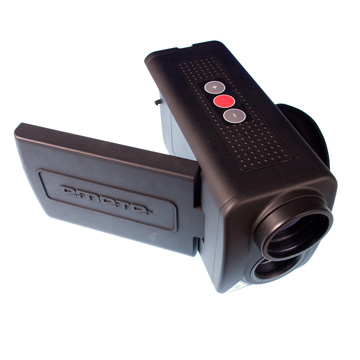 The Amata laser radar is able to accurately measure the speed and distance of vehicles and record traffic violations using photo or video shooting. The device operates on the basis of a laser speed meter, which allows you to reliably select the car the traffic police inspector needs from a dense traffic stream. The Amata lidar is equipped with a sighting mark, which on the device’s display or in the photo coincides with the direction of the laser beam and is evidence of measuring the speed of a particular car.
The Amata laser radar is able to accurately measure the speed and distance of vehicles and record traffic violations using photo or video shooting. The device operates on the basis of a laser speed meter, which allows you to reliably select the car the traffic police inspector needs from a dense traffic stream. The Amata lidar is equipped with a sighting mark, which on the device’s display or in the photo coincides with the direction of the laser beam and is evidence of measuring the speed of a particular car.
Characteristics
Device type lidar, photofixer
Laser wavelength 800–1100 nm
Controlled directions of movement all directions
Speed measurement mode stationary, patrol
Detection range up to 700 m
Range of measurement of speed 1,5—280 km / h
Measurement error ± 2 km / h
 Radar is a reliable and efficient speed meter operating in the K-band. For 15 years, the radar has been successfully used by road guard services to control the speed limit on Russian roads. Iskra-1 operates at a double frequency of the K-band, which significantly increases the reliability of measurements in adverse weather conditions. A distinctive feature of the Iskra-1 models is the monopulse method of measuring speed. This mode provides high performance of the device: the radar calculates the vehicle’s motion parameters in just 0.2 seconds. Moreover, the radar is practically invisible to all radar detectors of foreign manufacture that are not adapted to the Russian conditions: they all perceive the Iskra short-pulse signal as an obstacle.
Radar is a reliable and efficient speed meter operating in the K-band. For 15 years, the radar has been successfully used by road guard services to control the speed limit on Russian roads. Iskra-1 operates at a double frequency of the K-band, which significantly increases the reliability of measurements in adverse weather conditions. A distinctive feature of the Iskra-1 models is the monopulse method of measuring speed. This mode provides high performance of the device: the radar calculates the vehicle’s motion parameters in just 0.2 seconds. Moreover, the radar is practically invisible to all radar detectors of foreign manufacture that are not adapted to the Russian conditions: they all perceive the Iskra short-pulse signal as an obstacle. Characteristics
Type Radar
Operating frequency of the speed meter 24050-242550 MHz (K-band)
Controlled directions of movement all directions
Speed measurement mode stationary, patrol (on the move)
Detection range up to 800 m
Speed measurement range 30–220 km / h
Measurement error ± 1 km / h
Model number
"Spark-1B" is intended to work in a steady state, preferably in one direction. The radar allows you to select a vehicle in the traffic stream with the highest speed in almost any conditions, exceeding the flow rate by only 5 km / h.
Iskra-1D is the first Russian radar capable of operating in all directions in a moving patrol car. In one second, the radar manages to make a five-fold measurement of the target’s own speed and speed, eliminate possible errors, process the measurement results and display them on a display that consistently displays the target’s speed, own speed and time from the start of the measurement.
Radar Sokol-M
 The Sokol-M mobile radar is an autonomous radar speed meter operating in the obsolete X-band. The device is designed to determine the speed of oncoming cars only. Dimensional, easy to use, the radar is able to control the speed of both individual cars and those moving in the stream at a distance of 300-500 m. It is perfectly recognized by "white" radar detectors of any price category. The Sokol-M radar was discontinued in 2008, but due to its high reliability, ease of use and relatively low price, it is now widely used in Russia and the Commonwealth countries.
The Sokol-M mobile radar is an autonomous radar speed meter operating in the obsolete X-band. The device is designed to determine the speed of oncoming cars only. Dimensional, easy to use, the radar is able to control the speed of both individual cars and those moving in the stream at a distance of 300-500 m. It is perfectly recognized by "white" radar detectors of any price category. The Sokol-M radar was discontinued in 2008, but due to its high reliability, ease of use and relatively low price, it is now widely used in Russia and the Commonwealth countries. Characteristics
Instrument type radar
Operating frequency of the speed meter 10500-10550 MHz (X-band)
Controlled directions of movement all directions
Speed measurement mode stationary patrol (in motion)
detection range up to 600 m
of speed measurement range of 20-250 km / h
measurement error ± 2 km / h
Lineup
"Falcon-M-C" is intended to control the stationary-speed mode and has an adjustable range of actions. All Sokol-M models operate in Ultra-X pulsed mode, which makes these radars elusive for radars of the lowest price category and models that are not adapted for use in Russian conditions.
Sokol-MD is intended for measuring the speed of oncoming and passing vehicles in a moving patrol car.
"Sokol-Visa" - a mobile complex for measuring speed and video recording is a Sokol-M radar, which is paired with a digital video camera. The system operates in a stationary mode (installed primarily on a stationary patrol car) and can only measure the speed of oncoming cars. The Sokol-Visa complex captures on the video not only violations of the high-speed mode, but also traffic to a red light and the intersection of solid lanes - it is almost impossible to challenge such a charge of violating traffic rules.
Radar "Binar"
 A feature of Binar is the presence of two cameras: the first serves for a wide overview of the traffic situation, the second takes close-up shots of the intruder’s car with a distinguishable license plate at a distance of up to 200 m. The device is able to work stationary or while the patrol car traffic police. The presence of two videos in addition to the readings of the radar simplify the control of the situation on the road and increase the reliability of identifying a traffic violator. "Binar" is equipped with a non-volatile memory card in SD format, has a low weight, is able to charge from the vehicle's on-board network and can synchronize with a computer. Radar control is carried out using the remote control or touch screen.
A feature of Binar is the presence of two cameras: the first serves for a wide overview of the traffic situation, the second takes close-up shots of the intruder’s car with a distinguishable license plate at a distance of up to 200 m. The device is able to work stationary or while the patrol car traffic police. The presence of two videos in addition to the readings of the radar simplify the control of the situation on the road and increase the reliability of identifying a traffic violator. "Binar" is equipped with a non-volatile memory card in SD format, has a low weight, is able to charge from the vehicle's on-board network and can synchronize with a computer. Radar control is carried out using the remote control or touch screen. Characteristics
Instrument type radar, video fixer
Operating frequency of the speed meter 24050-242550 MHz (K-band)
Controlled directions of movement all directions
Speed measurement mode stationary, patrol
Detection range up to 300 m
Speed measurement range 20-300 km / h
Measurement error ± 2 km / h
Radar Radis
 Radar "Radis" has high accuracy and fast measurement speed with the ability to select the nearest or fastest car from the traffic stream. The device is capable of measuring speed in both the opposite and the associated directions, it is equipped with two displays with bright backlight and has simple controls using the on-screen menu. The radar is capable of taking speed measurements while charging from the vehicle’s on-board network. The weight of the device is only 450 g. Radis can be installed in the cabin, as well as on the hood or roof of a patrol car using a magnetic stand. Using the remote control, the radar can be controlled remotely.
Radar "Radis" has high accuracy and fast measurement speed with the ability to select the nearest or fastest car from the traffic stream. The device is capable of measuring speed in both the opposite and the associated directions, it is equipped with two displays with bright backlight and has simple controls using the on-screen menu. The radar is capable of taking speed measurements while charging from the vehicle’s on-board network. The weight of the device is only 450 g. Radis can be installed in the cabin, as well as on the hood or roof of a patrol car using a magnetic stand. Using the remote control, the radar can be controlled remotely. Characteristics
Instrument type radar
Operating frequency of the speed meter 24050-242550 MHz (K-band)
Controlled directions of movement all directions
Speed measurement mode stationary, patrol
Detection range up to 800 m
Speed measurement range 10-300 km / h
Measurement error ± 1 km / h
Radar "Golden eagle"
 The Berkut police radar is designed to control the speed of single vehicles or cars in heavy traffic. It has the ability to select the nearest or fastest car. The radar is equipped with a backlight indicator and buttons, allowing the traffic police inspector to record the speed of the car in the dark. The Golden Eagle can work for 10 hours without recharging and measure the speed both stationary and in patrol mode. The radar is easy to use and easy to mount on the dashboard of a car. Depending on the situation, you can attach a handle, bracket or video clip to the device.
The Berkut police radar is designed to control the speed of single vehicles or cars in heavy traffic. It has the ability to select the nearest or fastest car. The radar is equipped with a backlight indicator and buttons, allowing the traffic police inspector to record the speed of the car in the dark. The Golden Eagle can work for 10 hours without recharging and measure the speed both stationary and in patrol mode. The radar is easy to use and easy to mount on the dashboard of a car. Depending on the situation, you can attach a handle, bracket or video clip to the device. Characteristics
Instrument type radar
Operating frequency of the speed meter 24050-242550 MHz (K-band)
Controlled directions of movement all directions
Speed measurement mode stationary
Detection range up to 800 m
Speed measurement range 20-250 km / h
Measurement error ± 2 km / h
Radar “Vizir”
 While determining the speed, the Vizir radar takes photos and videos of the intruder’s car, which helps the traffic police inspector to resolve disputes. The results of speed measurements, as well as the control date and time, are entered into the picture taken by the Vizier. The device takes measurements in all directions and is able to work both stationary and in a patrol car. The radar is equipped with a built-in LCD display and a simple menu with a convenient arrangement of control keys. The device has a function of automatic speed measurement and recording traffic violations. "Vizir" can be connected to an external monitor and transfer data to a computer.
While determining the speed, the Vizir radar takes photos and videos of the intruder’s car, which helps the traffic police inspector to resolve disputes. The results of speed measurements, as well as the control date and time, are entered into the picture taken by the Vizier. The device takes measurements in all directions and is able to work both stationary and in a patrol car. The radar is equipped with a built-in LCD display and a simple menu with a convenient arrangement of control keys. The device has a function of automatic speed measurement and recording traffic violations. "Vizir" can be connected to an external monitor and transfer data to a computer. Characteristics
Instrument type radar, video
fixator Operating frequency of the speed meter 24050-242550 MHz (K-band)
Controlled directions of movement all directions
Speed measurement mode stationary, patrol
Detection range up to 600 m
Speed measurement range 20–250 km / h
Measurement error ± 2 km / h
Strelka radar complex The Strelka
 radar complex accurately measures the speed of all vehicles, caught in its coverage area (500 m from the installation site), regardless of the density of the traffic flow. The Strelka camera records the excess of the set speed limit at a distance of 350 to 50 m to the installation site and photographs the intruder’s car with clearly distinguishable license plates. The received data is processed by a computer and transmitted to the information processing center via a fiber optic line or via a radio channel.
radar complex accurately measures the speed of all vehicles, caught in its coverage area (500 m from the installation site), regardless of the density of the traffic flow. The Strelka camera records the excess of the set speed limit at a distance of 350 to 50 m to the installation site and photographs the intruder’s car with clearly distinguishable license plates. The received data is processed by a computer and transmitted to the information processing center via a fiber optic line or via a radio channel.Characteristics
Instrument type radar, photofixer
Operating frequency of the speed meter 24050–24250 MHz (K-band)
Controlled directions of movement all directions (up to 4 lanes)
Speed measurement mode stationary, patrol
Detection range up to 500 m
Minimum detection range 50 m
Speed measurement range 20-300 km / h
Measurement accuracy ± 1 km / h Strelka-01-ST
model range
is a stationary device installed above the carriageway and transmitting information to the control center via fiber optic communication.
"Strelka-01-STR" is a stationary device installed above the carriageway and transmitting information to the radio control center.
"Arrow-01-STM" - a mobile version of the device with the possibility of placement on a patrol car.
Radar complex "Arena" The
 hardware-software complex "Arena" is designed to automatically control the speed limit on a specific section of the road. Preparation of the complex for work takes about 10 minutes. “Arena” is mounted on a tripod 3-5 m from the edge of the roadway. Cars that exceed the high-speed threshold are automatically photographed, and information about violations is transmitted to the traffic police post or stored in the device's memory. The radar complex is powered by a battery located nearby in a special box.
hardware-software complex "Arena" is designed to automatically control the speed limit on a specific section of the road. Preparation of the complex for work takes about 10 minutes. “Arena” is mounted on a tripod 3-5 m from the edge of the roadway. Cars that exceed the high-speed threshold are automatically photographed, and information about violations is transmitted to the traffic police post or stored in the device's memory. The radar complex is powered by a battery located nearby in a special box. Characteristics
Instrument type radar, photofixer, agribusiness
Operating frequency of a speed meter 24050-242550 MHz (K-band)
Controlled directions of movement oncoming
Speed measurement mode stationary
Detection range up to 90 m
Speed measurement range 20–250 km / h
Measurement error ± 2 km / h
Chris photoradar complex The Chris
 photoradar complex is designed to automatically record traffic violations, recognize vehicle numbers, and check them by federal or regional databases and data transfer to a remote traffic police post. The device is equipped with an infrared camera, which allows it to work at night. "Chris" is installed on a tripod near the edge of the roadway and will measure the speed of only those cars that are in the frame.
photoradar complex is designed to automatically record traffic violations, recognize vehicle numbers, and check them by federal or regional databases and data transfer to a remote traffic police post. The device is equipped with an infrared camera, which allows it to work at night. "Chris" is installed on a tripod near the edge of the roadway and will measure the speed of only those cars that are in the frame. Characteristics
Instrument type radar, photofixer
Operating frequency of the speed meter 24050–24250 MHz (K-band)
Controlled directions of movement all directions
Speed measurement mode stationary
Detection range up to 150 m
Speed measurement range 20-250 km / h
Measurement error ± 1 km / h Chris-S
model range
is a standard model of a photo radar complex.
Chris-P is an improved model with a new photoradar sensor.
Radar "Rapira-1"
 Radar "Rapira-1" is used only for stationary measurement of speed of vehicles, it is able to work separately or as part of various hardware and software systems. The radar is installed at a distance of 4-9 meters above the road at an angle of 25 ° and allows you to determine the speed of the car in a narrow control zone.
Radar "Rapira-1" is used only for stationary measurement of speed of vehicles, it is able to work separately or as part of various hardware and software systems. The radar is installed at a distance of 4-9 meters above the road at an angle of 25 ° and allows you to determine the speed of the car in a narrow control zone. Characteristics
Instrument type radar, photofixer
Operating frequency of the speed meter 24050-242550 MHz (K-band)
Controlled directions of travel oncoming
Speed measurement mode stationary
Detection range up to 20 m
Speed measurement range 20-250 km / h
Measurement accuracy ± 2 km / h
Laser radar LISD-2
 Laser radar "Lysd-2" is designed to measure speed and range to various objects, uses narrowly focused light radiation to highlight a specific car in a dense stream of vehicles. The lidar is made in the form of binoculars with an optical sight, it works only stationary, but measures speed in all directions. The shoulder strap is mounted and the device can be mounted on a tripod.
Laser radar "Lysd-2" is designed to measure speed and range to various objects, uses narrowly focused light radiation to highlight a specific car in a dense stream of vehicles. The lidar is made in the form of binoculars with an optical sight, it works only stationary, but measures speed in all directions. The shoulder strap is mounted and the device can be mounted on a tripod. Specifications
Type of device lidar, photofixer
Laser wavelength 800–1100 nm
Controlled directions of movement all directions
Speed measurement mode stationary
Detection range up to 400 m
Speed measurement range 1–200 km / h
Measurement error ± 2 km / h
Model range
“Lysd-2M” - standard lidar model.
LISD-2F is an improved model equipped with a photofixation unit.
Laser radar "Amata"
 The Amata laser radar is able to accurately measure the speed and distance of vehicles and record traffic violations using photo or video shooting. The device operates on the basis of a laser speed meter, which allows you to reliably select the car the traffic police inspector needs from a dense traffic stream. The Amata lidar is equipped with a sighting mark, which on the device’s display or in the photo coincides with the direction of the laser beam and is evidence of measuring the speed of a particular car.
The Amata laser radar is able to accurately measure the speed and distance of vehicles and record traffic violations using photo or video shooting. The device operates on the basis of a laser speed meter, which allows you to reliably select the car the traffic police inspector needs from a dense traffic stream. The Amata lidar is equipped with a sighting mark, which on the device’s display or in the photo coincides with the direction of the laser beam and is evidence of measuring the speed of a particular car. Characteristics
Device type lidar, photofixer
Laser wavelength 800–1100 nm
Controlled directions of movement all directions
Speed measurement mode stationary, patrol
Detection range up to 700 m
Range of measurement of speed 1,5—280 km / h
Measurement error ± 2 km / h
Radar detector
Legality The
use of radar detectors is officially authorized in Russia, Ukraine, Belarus, Moldova, Kazakhstan and all other countries of the Commonwealth, in the USA (except for the state of Virginia and in Washington, DC), Great Britain, Iceland, Bulgaria, Romania, Slovenia, Albania, Israel , Japan, India, Pakistan, Taiwan, New Zealand.
Radar detectors are prohibited for use in Canada (except the states of British Columbia, Alberta and Saskatchewan), Brazil, Finland, Norway, Sweden, Belgium, Ireland, Switzerland, Denmark, Germany, Austria, Holland, Luxembourg, France, Spain, Portugal, Italy , Greece, Croatia, Serbia, Slovakia, Poland, Hungary, Bosnia, the Czech Republic, Estonia, Latvia, Lithuania, Turkey, Jordan, Singapore, Malaysia, Egypt, Saudi Arabia, the United Arab Emirates, South Africa, Australia (excluding the state of Western Australia).
History

The world's first radar detector for motorists
Promoted such gadgets through the magazine "Popular Electronics" (1961):

Source
Later models:


Museum of radar detectors - www.radardetectormuseum.com The
interiors of modernradar detector SHO-ME 520 STR

Bottom view

With the radiator removed (corrected in the comments - this is an RF screen. It just shields the local oscillator radiation and also protects the receiving path from external interference. Thanks r00tGER ). At the top left is a laser detector, below is a copper horn antenna. In the center is the HF module. To the right - 3 control buttons. Right (white) - Display

Under the RF screen

detailed description of components on a similar device

False signals are radio signals from other devices operating in the ranges of police radars, but which have nothing to do with the latter. For example, automatic store doors can operate in the X- and K-bands, satellite equipment signals can be detected by the X-band radar detector, radio signals of all ranges, as well as laser signals, can be detected in territories adjacent to airports.
Radar detectors use software and hardware methods of protection against false radio signals. Hardware methods involve the installation of specialized filters in the receiver of a radar detector, and software methods include special algorithms that can identify a radar signal and cut off its signal from interference. But sometimes these methods are not enough, especially when using a radar detector in an urban environment with a lot of interference from foreign devices. To do this, all modern radar detectors have a manual change in the sensitivity of the device - switching between the "City" and "Track" modes. Depending on the "jamming" situation, the driver can independently adjust the sensitivity of his device and minimize the number of false positives of the radar detector.
Active Radar Detectors

Antiradar is an active type device. It is equipped not only with a radio receiver for signal detection, but also with a radio transmitter that emits signal interference. It is this signal that disrupts the work of police radars: it mixes the signal coming from the radar with radio noise (“white noise”). The radar radio receiver receives a distorted signal and cannot determine the speed of the machine, to which the radio signal was sent.
These devices are prohibited almost everywhere. This device is included in the list of devices included in the Law “On counteraction to traffic authorities”.
Laser Radar Detector
During their work, in response to the signal sent by the police radar, laser radar detectors send their shifted in phase. As a result, the policeman receives an underestimated speed value. It is worth noting that the price range for devices of this type is significant. This is explained both by the manufacturer’s brand and its “hype” in the market, as well as by the manufacturing method and the used components. The most expensive are laser radar detectors of a hidden or spaced installation, as well as those capable of simultaneously processing a large number of (up to eight) signals simultaneously, determining the power and level of the signal.
It is also not recommended to use “jammers” against lidars, as they are already included in the list of the Law “On counteraction to traffic authorities”.
Laser Jammer Demo:
Radar Detector Detector

High Sensitive Direction Finder
In a number of foreign countries, radar detectors are prohibited by law. In order to determine whether a radar detector is in the car or not, the VG-2 system (16000 MHz) was invented. The principle of operation - the machine is irradiated with a signal of a certain frequency, because there are many radio parts inside the radar detector, they cause “interference” to this signal and, by their presence or absence, the device gives out whether the radar detector is in the car or not.
Modern radar detector have the function of detecting VG-2 devices (in fact, when a VG-2 is detected, the radar simply turns off for a while).
All radar detectors can be divided into 2 main groups - heterodyne and direct amplification. Direct gain detectors cannot initially be detected by such devices. they have structurally no radiation. In heterodyne detectors, in the process of signal processing, a local oscillator is used, which is a radiation source (minimal, but there is). It is this radiation that can be captured by supersensitive devices to search for a radar detector at a distance. The distance can reach several hundred meters.
With the VG-2 option in the detector, the radar detector, in addition to the usual radar frequencies, also scans this allocated frequency for the detection of a signal from such a device. When a signal is detected, all local oscillators in the detector are turned off, and with them the reception of radar signals and thus the detector is protected from detection. The detector is fully switched on only after the signal disappears in the VG-2 range.
In addition to VG-2, which is already an outdated technology, there are Spectrum-type devices that also remotely detect the presence of a heterodyne radar detector in a car. Unlike VG-2, the Spectrum does not have a dedicated frequency and therefore it cannot be detected in advance. The only protection against detection by Spectra is to reduce the radiation level of the local oscillator due to shielding and the use of low-noise signal amplifiers.
Counteraction to the detector of radar detectors
1. Do not use a local oscillator in the design of the radar detector - there are no radiating elements, there is no problem, but the direct amplification radar detector is not very sensitive;
2.VG-2 systems can be counteracted by turning off the local oscillator and this is done in most radar detectors. As soon as the radar detector detects a signal in the VG-2 range, it turns off the local oscillator and thus prevents detection. When using this method, there is one very important side effect - at the time the VG-2 signal is detected, the radar detector cannot detect radar signals since its local oscillator is disconnected. This method works only with VG-2, and the Spectrum systems have a different principle and this method is not possible.
3.To counter the Spectra, manufacturers of the radar detector by all available means reduce the radiation emitted by the local oscillator to the outside. For this, shielding, metal cases, resonance tuning are used - these are among the passive methods. Active ones include the use of low noise amplifiers (LNAs), lower local oscillator frequencies, etc. methods. Using several methods at the same time can protect the radar detector from detection, but there are not many completely undetectable radar detectors, but their number is constantly increasing as manufacturers switch to higher technologies. The first completely undetectable radar detector was the Beltronics STi. When using this method of counteraction, there are no side effects.
In Russia, the functions of VG and Specter are not relevant, since we do not have a ban on the use of radar detectors, although the media now and then there are notes on attempts by the authorities of certain regions to introduce such restrictions, such as in Tatarstan.
A large box catches a small box:
DIY
What is happening in the do-it-yourself environment and at hacker conferences.

Scheme for self-assembly of a radar detector for radio amateurs (1958)
How to gash your radar. In detail
The hacker’s job of making coffee can’s radar is based on the scientific publication of a doctor from MIT, which describes the possibility of creating 2D and 3D images using aperture radar synthesis

In Massachusetts, they even took a course on this subject
DEFCON 19: Build your own Synthetic Aperture Radar:
For 900 bucks you can buy a kit for assembly :

Anboxing training kit with cans:
Device for testing radar detectors and laser jammers

Test your radar detector or laser jammer with this traffic enforcement LIDAR gun simulator
If you want to build your own laser jammer or your own laser radar detector, you will need this device that simulates the operation of police laser detection systems.
The device mimics one of 11 systems:
- Jenoptik laveg
- Jenoptik laserpatrol
- Kustom Prolaser 1
- Kustom Prolaser 2
- Kustom Prolaser 3
- Kustom prolite
- Laser atlanta
- Stalker LZ-1
- Ultralyte 100/200 LR Revision 1
- Ultralyte 100/200 LR Revision 2
- Ultralyte Non-LR
each of which runs on 904nM, some systems emit 100 pulses per second, some 238.
We test our gadget for vulnerabilities.
Radar Gun Hacked!

From a toy:

For $ 25
With a saw, washers and a bottle:

Make a device for those who want to become a policeman:

Need more power
Another comrade was not satisfied with the power of the previous “toy” (10 meters), and he washed down his horn antenna and amp: the

craftsman wants to measure the speed of airplanes. He figured out the relics, but the next step is to upgrade the chip, because it has a speed limit of 100 mph, and he needs more. ( Source )
Old School Police Radar Hack

Having found grandfather's radar in the attic, the craftsman fiddled with the oscilloscope and soldered the adapter from the radar to the laptop through the audio input. And then he successfully processed the signal on the computer.
source
P.S.
Bearded story
Двое полицейских из калифорнийского дорожного патруля сидели в засаде с радаром на трассе I-15, слегка к северу от аэродрома морпехов в Мирамаре.
Один из них вознамерился было измерить скорость машин, выезжающих на пригорок, что прямо перед ними.
Как вдруг… радар стал показывать 500 км/ч.
Полисмен попытался сбросить программу радара, но программа сбрасываться отказалась, а затем и сам радар выключился.
После чего оглушающий рев, исходящий откуда-то с верхушек деревьев, разъяснил, что радар отслеживал морпеховский F/A-18 Hornet (пр-ва фирмы Нортроп-Грамман), совершавший поблизости упражнение по низким полетам.
Капитан полицейского управления направил жалобу командиру базы морпехов.
Пришедший ответ был выдержан в истинно морпеховском стиле:
«Благодарим вас за ваше письмо. Мы, наконец, можем закрыть папку с этим инцидентом. Вам может быть интересен тот факт, что тактический компьютер Хорнета обнаружил присутствие и начал сопровождение вашего неприятельского радара, почему и послал ответный сигнал подавления, отчего ваш радар и отключился.
Далее, ракета „Воздух-Земля“, являющаяся частью амуниции полностью вооруженного на тот момент самолета, так же автоматически нацелилась на местоположение вашего оборудования.
К счастью, пилот Морской Пехоты, управлявший Хорнетом, правильно оценил ситуацию, и, быстро среагировав на возникший статус тревоги ракетной системы, смог перехватить управление автоматической системой защиты прежде, чем ракета была выпущена для уничтожения местоположения неприятельского радара.
The pilot also suggests that you keep your mouth shut when you swear at him, as the video system on this type of aircraft is very high-tech. Sergeant Johnson, the policeman holding the radar, needs to consult his dentist about the back left molar. It looks like the seal in it is loose.
He also has a broken holster clasp.
Thank you for your concern.
Semper Fi »
Один из них вознамерился было измерить скорость машин, выезжающих на пригорок, что прямо перед ними.
Как вдруг… радар стал показывать 500 км/ч.
Полисмен попытался сбросить программу радара, но программа сбрасываться отказалась, а затем и сам радар выключился.
После чего оглушающий рев, исходящий откуда-то с верхушек деревьев, разъяснил, что радар отслеживал морпеховский F/A-18 Hornet (пр-ва фирмы Нортроп-Грамман), совершавший поблизости упражнение по низким полетам.
Капитан полицейского управления направил жалобу командиру базы морпехов.
Пришедший ответ был выдержан в истинно морпеховском стиле:
«Благодарим вас за ваше письмо. Мы, наконец, можем закрыть папку с этим инцидентом. Вам может быть интересен тот факт, что тактический компьютер Хорнета обнаружил присутствие и начал сопровождение вашего неприятельского радара, почему и послал ответный сигнал подавления, отчего ваш радар и отключился.
Далее, ракета „Воздух-Земля“, являющаяся частью амуниции полностью вооруженного на тот момент самолета, так же автоматически нацелилась на местоположение вашего оборудования.
К счастью, пилот Морской Пехоты, управлявший Хорнетом, правильно оценил ситуацию, и, быстро среагировав на возникший статус тревоги ракетной системы, смог перехватить управление автоматической системой защиты прежде, чем ракета была выпущена для уничтожения местоположения неприятельского радара.
The pilot also suggests that you keep your mouth shut when you swear at him, as the video system on this type of aircraft is very high-tech. Sergeant Johnson, the policeman holding the radar, needs to consult his dentist about the back left molar. It looks like the seal in it is loose.
He also has a broken holster clasp.
Thank you for your concern.
Semper Fi »
